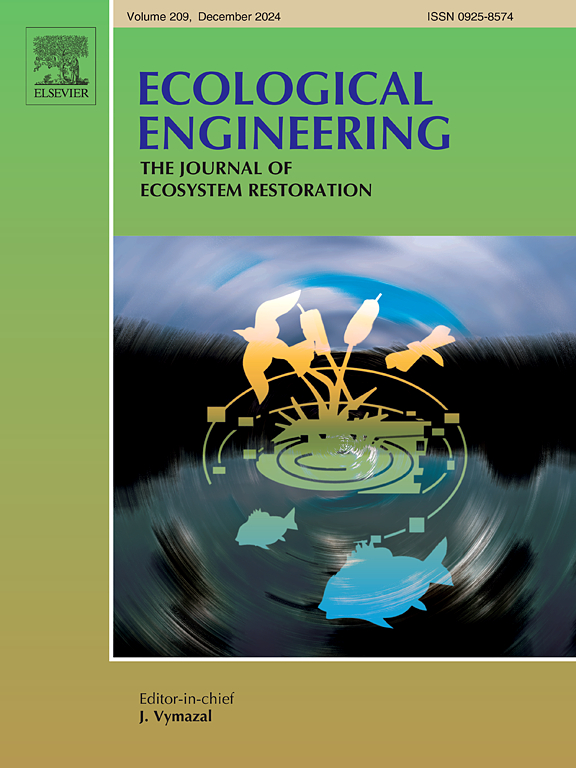喷施生态混凝土对公路砌体边坡植被恢复效果评价
IF 4.1
2区 环境科学与生态学
Q1 ECOLOGY
引用次数: 0
摘要
传统的公路边坡通常采用框架梁、拱网和喷射混凝土等砌体结构来稳定。然而,随着时间的推移,暴露在降雨,阳光和温度波动的风化下会导致变形,滑动,甚至结构破坏,这通常会导致开裂,损坏,落石或倒塌。此外,砌体结构的不透水性限制了边坡土壤与周围环境之间的水和空气交换,为公路边坡的植被恢复带来了重大挑战。在云茂高速公路某隧道入口进行了喷淋生态混凝土边坡稳定与植被恢复的现场试验。在1080天的时间里,对边坡的物理化学性质、植物群落和边坡稳定性进行了监测和分析。结果表明,生态混凝土植被恢复技术显著提高了砌体边坡的植被性能。它对砌体边坡下垫土具有优越的物理和化学性质,为种子萌发和植物长期生长提供支持。该技术成功地重建了砖石边坡上的多层“草-灌木-花”植被结构。提高边坡稳定性,增强抗侵蚀能力,防止砌体边坡风化剥落。建立了植被恢复效果评价体系。采用模糊层次分析法(F-AHP)建立了由生态混凝土物理性能、生态混凝土化学性能、植物群落和边坡稳定性4个主要评价层组成的16个评价层体系,评价结果为“优”,与现场条件基本一致。研究结果表明,生态混凝土技术有效解决了砌体边坡植被恢复和边坡稳定的挑战,具有重要的应用潜力。本文章由计算机程序翻译,如有差异,请以英文原文为准。

Evaluation on effect of spraying ecological concrete on vegetation restoration of highway masonry slope
Traditional highway slopes are typically stabilized using masonry structures such as frame beams, arch grids, and shotcrete. However, over time, exposure to weathering from rainfall, sunlight, and temperature fluctuations can lead to deformation, sliding, and even structural failure which often result in cracking, damage, rockfalls, or collapses. Additionally, the impermeable nature of masonry structures restricts the exchange of water and air between the slope soil and the surrounding environment, creating significant challenges for vegetation restoration on highway slopes. At the entrance of a tunnel on the Yunmao Expressway, a field experiment utilizing sprayed ecological concrete for slope stability and vegetation restoration was conducted. The physical and chemical properties of the slope, along with plant communities and slope stability, were monitored and analyzed over 1080 days. The results indicate that ecological concrete vegetation restoration technology significantly enhances the vegetation performance of masonry slopes. It possesses superior physical properties and chemical properties to soil underlying masonry slopes, providing support for seed germination and long-term plant growth. This technology successfully reconstructs a multi-layered “grass-shrub-flower” vegetation structure on the masonry slopes. Furthermore, it improves slope stability, enhancing the erosion resistance and preventing weathering and peeling of the masonry slope. An evaluation system was established to assess vegetation restoration effectiveness. The system is composed of four main criteria layers: physical properties of ecological concrete, chemical properties of ecological concrete, plant communities, and slope stability comprising a total of 16 indicator layers, was established based on the Fuzzy Analytic Hierarchy Process (F-AHP), The evaluation results indicate the vegetation restoration effectiveness as “excellent”, which is consistent with the field conditions. The findings demonstrate that ecological concrete technology effectively addresses the challenges of vegetation restoration and slope stability on masonry slopes, offering significant potential applications.
求助全文
通过发布文献求助,成功后即可免费获取论文全文。
去求助
来源期刊

Ecological Engineering
环境科学-工程:环境
CiteScore
8.00
自引率
5.30%
发文量
293
审稿时长
57 days
期刊介绍:
Ecological engineering has been defined as the design of ecosystems for the mutual benefit of humans and nature. The journal is meant for ecologists who, because of their research interests or occupation, are involved in designing, monitoring, or restoring ecosystems, and can serve as a bridge between ecologists and engineers.
Specific topics covered in the journal include: habitat reconstruction; ecotechnology; synthetic ecology; bioengineering; restoration ecology; ecology conservation; ecosystem rehabilitation; stream and river restoration; reclamation ecology; non-renewable resource conservation. Descriptions of specific applications of ecological engineering are acceptable only when situated within context of adding novelty to current research and emphasizing ecosystem restoration. We do not accept purely descriptive reports on ecosystem structures (such as vegetation surveys), purely physical assessment of materials that can be used for ecological restoration, small-model studies carried out in the laboratory or greenhouse with artificial (waste)water or crop studies, or case studies on conventional wastewater treatment and eutrophication that do not offer an ecosystem restoration approach within the paper.
 求助内容:
求助内容: 应助结果提醒方式:
应助结果提醒方式:


